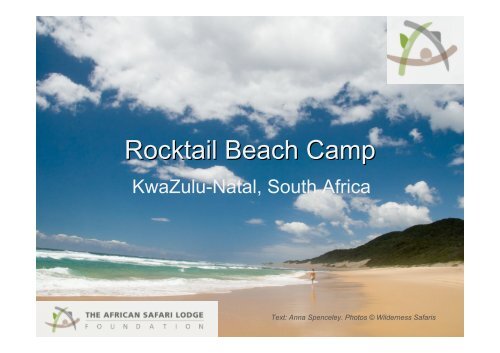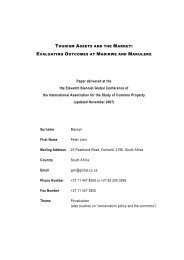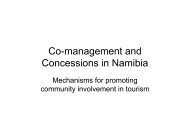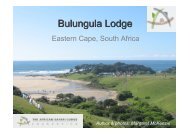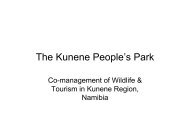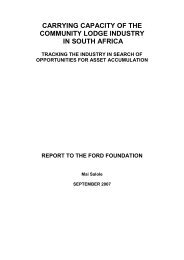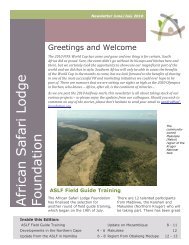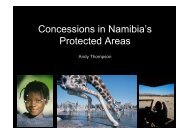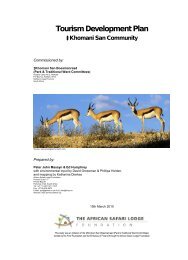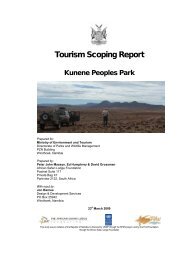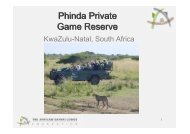Rocktail case presentation by Anna Spenceley - The African Safari ...
Rocktail case presentation by Anna Spenceley - The African Safari ...
Rocktail case presentation by Anna Spenceley - The African Safari ...
Create successful ePaper yourself
Turn your PDF publications into a flip-book with our unique Google optimized e-Paper software.
Contents• Overview of the initiative• Policy context• Planning and development issues:– Enterprise model and land tenure– Institutional arrangements• Tourism products and activities• Impacts of tourism– Environmental impacts and conservation– Social impacts, including training and skills development andstakeholders– Economic impacts, including value chain analysis, capitalstructure and commercial issues• Current issues and replicability
Overview of the initiative• 12-bed tented luxury camp in coastal forest reserve• Diving, fishing and beach tourism• Operated <strong>by</strong> Wilderness <strong>Safari</strong>s group, owned <strong>by</strong> jointventurePTY with KwaMpukane Community Trust• Joint-venture also developed iGugulesizwe communitycentre with various tourism tours and accommodationoutside reserve• Camp has concession agreement – 8.5% turnover paid tothe iSimangaliso Wetland Park Authority (IWPA) as rentalagreement, with 8% of rent given to community.• Various conservation and local economic developmentinitiatives• Neighbouring <strong>Rocktail</strong> Bay Lodge which has a tripartiteownership (WS, conservation authority, community)Clive Poultney
<strong>Rocktail</strong> BeachCamp
iGugulesizweCommunity Centre
Policy context• Concession policy for IWPA: RBC arrangement isover and above requirements – and allows activitiesoutside the Protected Area (PA)• NEMA:– 7 years to get RBC through Environmental ImpactAssessment (EIA) because EIA report was passed betweennational, provincial environmental agencies and the IWPA.Even though area was disturbed, that had been farmed inthe past.– Camp site option was blocked for disturbed area in dunes forcanoe trips in the estuary within the protected areaClive Poultney
Planning & development issues• Planning of the enterprise:– Context: Land leased from IWPA; EIA passed;WS negotiated directly with community (ratherthan via the Authority);– Infrastructure: Took 3 months to construct; usedexisting infrastructure from Manzengwenyaconservation office (e.g. existing electricity); 12canvas and timber 2-bed units; scuba divingtraining pool; local carpenters used forfurnishings/some construction; septic tanks withtreated water into evaporation pans; externallandscaper trained a local team landscapers(indigenous plants).Clive Poultney
• Chalets nestledamong trees
Planning & development issues:<strong>Rocktail</strong> Beach Lodge model & land tenureOwnership &DevelopmentManagementLand and wildlife estateIWPAIWPA (and contractactivities to EKZN Wildlifethe provincial conservationauthority)CommercialInfrastructureWS 75%JV company 25%Wilderness <strong>Safari</strong>s(but recruitment jointly withTrust & independentconsultancy company)• R2.5 million as EU grant provided to build extra 8 tents to complete lodge (as20-bed facility)• EU money effectively buys a share in the operation for the JV company (entirelodge cost R10 million to construct) with money for legal advice to brokeragreementsClive Poultney
Planning & development issues:Institutional Arrangements (RBeachC(RBeachC)Rental9% turnoverIWPALessor15+5-yr BOT &transfer to IWPAWilderness <strong>Safari</strong>s (75%) +Small Business DevelopmentCompany (25%)Lessee & Developer and OperatorKwaMpukaneCommunity Trust9 members electedfrom communitySmall Business DevelopmentCompany PTYJoint venture: WS + KwaMpukane Trust50%:50%2 members WS: 2 members Trust• JV company has 2 named WS directors; 2 KMT members – but this willchange to being 2 representatives of each organisation (problems withcontinuity if Trust members re-elected annually)• Single company doing ownership and development and management• KwaMpukane effectively owns 12.5% equity; WS effectively owns 87.5%Clive Poultney
Planning & development issues:Previously tried Institutional Arrangements• <strong>Rocktail</strong> Bay Lodge• Joint-venturearrangement did notwork well• Consistentmismanagement ofdividends that went toTrust, despite 3separate elections oftrustees• Few local benefitsrealised 29 jobsPoultney and <strong>Spenceley</strong>, 2001
Tourism products and activitiesWithin protectedarea (WS+JV):• Accommodation• Turtle night-drives• Scuba diving &snorkelling• Fishing• Beach activitiesOutside protected area(JV company):• iGugulesizwe communitycentre which includes:– 4 x 2-bed traditional beehivehuts for cultural tourismgroups (bar/reception)– Horse riding– Quad bike tours– Cultural and heritage hikingtrails– Star gazing– Community toursClive Poultney
ActivitiesStar gazing platform
Impacts of tourism• Environmental impacts andconservation• Social impacts, including training andskills development and stakeholders• Economic impacts, including valuechain analysis and commercial issues
Environmental impacts (1)Location:• <strong>Rocktail</strong> Beach Camp within disturbed coastal forest reserve.• iGugulesizwe centre on secondary dune outside reserve, on coastalsavannahConstruction:• EIA required for Beach Camp. A concern was butterfly flight path wheresleeping units were to be located. Toilets situated to avoid aquifers.Limited cutting of indigenous trees.Activities:• Quad bikes authorised <strong>by</strong> national legislation – guided trackestablished through old pine/eucalyptus plantation.• Horses enter the park on trails (no formal agreement with authority todo so) Will relocate horses and stables to centre (to get riders fromboth lodges).• Diving concession has strict environmental regulations, subcontracted<strong>by</strong> WS to diving operator (concession in WS name)Clive Poultney
Coastal forestSecondary dune
Environmental impacts (2)Conservation:• Turtle tours operate with a full time researcher paid <strong>by</strong> WS, who contributes toAuthority database daily.• R18500 per month for 5 month season (~US$12,200 p/a) – used forconservation in the provinceWaste:• Solid waste removed <strong>by</strong> truck to landfill tip in Manguzi.• JV plans to set up incinerator as small business in community area for waste• Planned recycling but need enough volume to attract private recyclingenterprise.• Sewage waste through septic tank & bacterial breakdown. Treated water used inplanted wetlands or evaporation pans (not mixing with ground or surface water).Water: Use ground water with boreholes (Beach Camp and centre). Generatorpumped. No grey water recycling – planned for future. Septic tanks and cleanedwater feeds a wetland system from the centre.Energy: Beach Camp and community centre – Eskom grid. No renewable energyused. Plans for hybrid energy systems in futureMaterials: Community centre – local wood and thatch all local materials. Beachcamp imported roofing material and canvas. Local material wood for tentplatforms; woven wattle mats.Clive Poultney
Social impacts (1)• Governance: Trust: elected trustees governed <strong>by</strong> constitution. Jointventure governed <strong>by</strong> articles of association (in progress).• Local population: 150 households in Mpukane community (6 peopleper homestead)• Local employment/education: WS facilitated visit <strong>by</strong> local EducationAuthority to see state of school, which then spent R2.5 m to upgrade it.• Low education levels. Migrant labour. Livestock low. Limitedsubsistence agriculture. Fishing• Donations: None yet from lodge. Donations in-kind in training from WSto community, to maintain community facility, paying for projectmanager of community facility. Will be facility for tourists to donate tothe Trust (e.g. for education, health)• Social problems:– Syndicated crime from Mozambique using local people from Mpukane. Sent6 people for ‘concession security’ training – and will be employed <strong>by</strong> thethree enterprises.– Policing forums at <strong>Rocktail</strong> Bay Lodge were inadequate.Clive Poultney
Traditional healer (sangoma)
Social impacts:Training and skills development• Lodge training for employees.• Chefs (5 pple) and guiding courses (6 pple) paid forWS for staff for the <strong>Rocktail</strong> Bay Lodge.• Courses organised <strong>by</strong> service providers via the IWPA• Trainees put into <strong>Rocktail</strong> Bay Lodge for testing.• WS training providers also provided in hospitality,bookeeping etc.• Trainees split between Beach Camp and communitycentreClive Poultney
Social impacts:Stakeholders and their role• Local people: Mpukane community. KwaMpukaneCommunity Trust to represent them• NGOs: Overseas Development Institute - PPT pilotson <strong>Rocktail</strong> Bay Lodge provided testing ground forfrom which current institutional arrangementsdeveloped• Donors: GtZ; EU Gijima• Private sector: Wilderness <strong>Safari</strong>s, MbozaEnterprises (consultant)• Government: IWPAClive Poultney
Economic impacts (1)• Ownership/equity: Local equity (12.5%) in JV company, withWilderness safaris.• Employment: 32 local employees earning average of R1682(US$$221) p/m (3 employees from elsewhere); seasonal/ casualwork• Procurement: Local craft. Catering for groups on per-event basis atcommunity centre with local food. Plan for agricultural centre forfood. Other items purchased for lodge from Richards Bay town.• Investment in small businesses: Will be a micro-enterprise fundfrom the JV.• Impact on poverty: Based onarea above poverty line of US$1per day (32 employees and 203average wage, implies 235people in local dependents)• Other: Food from lodge givento school every 2 nd day;Clive Poultney
Economic impacts:<strong>Rocktail</strong> Beach Camp:Capital structure (1)• Total investment R11.7 m ($1.5 m):– Grants of R4.2 m (US$550 k):• R 2.5-million from EU to JV fordevelopment• R 1.7-million from EU for supportservices (legal advice, facilitation,consultancies, support services forcommunity centre– Interest-bearing loan from WS Central(borrowed from IDC) of R7.5 m (US$1million)Clive PoultneyLoan64%Grant36%Clive Poultney
Economic impacts:Capital structure (2)iGugulesizwe communitycentre:• Grants of R1.5 m (US$200 k):– R 800k from GtZ– R 700 k from WS forfacilitation, project managerconstruction fees, centremanager salary (during set-up)WSgrant47%GTZgrant53%Clive Poultney
Economic impacts:Commercial issues (1)• Viability: Too early to look at profitability; linked to <strong>Rocktail</strong> Bay Lodge, 4x4access or pick-up); 4 hrs drive from Durban; 7 hrs drive from Joburg; fly into tarairstrip• <strong>Rocktail</strong> Beach Camp– Accommodation R1300 pp including 2 activities (R1050 without activities)– Scuba diving – R350 per dive– Snorkelling from boat – R250 pp– Lala Neck snorkelling – R150 (if use vehicle)• iGugulesizwe community centre– 4 x 2-bed traditional beehive huts for cultural tourism groups (bar/reception) – R590 pp– Horse riding - R300 pp– Quad bike tours – R300 pp– Star gazing – R150 ppClive Poultney
Economic impacts:Commercial issues (2)• Marketing: Through Wilderness; separate from <strong>Rocktail</strong> BayLodge) travel markets (UK/US); brochures; internet; agentworkshops to update; direct bookings; guide books• Visitation and demand: In 2007 86% domestic and 14%foreign tourists.– March 2008 bed occupancy: 56%– April 2008 bed occupancy: 45%• Communication: via head office (email etc). Cellphonereception (for communication with head office). Satellitephone for lodge. No direct communication between touristsand lodgesClive Poultney
Current issues and replicabilityStrengths:New joint-venture arrangement – return to thecommunity is more equitable and will in longer termsustain community-based enterprises (and will bemainstreamed)Lodge falls under second brand (more accessibleand affordable) better suited to South <strong>African</strong>properties.Funding support from EU and GtZ but not long termdependent on donors – because this input will beginto generate returns for SBDC; support from WSOpportunitiesMicro-funding from the Small BusinessDevelopment CompanyPurchasing of local furnishingCreation of new marketsVegetable gardensJobsLinkages to other lodgesWeaknessesTrust revenue dependent on strength of market as local benefitsrelated to turnover.JV benefits dependent on good occupancies.No renewable energyLimited water conservationThreatsCrimeCould exacerbate community conflicts e.g. power betweenTraditional Authority and democratically elected Trust.Market failure.Clive Poultney
Current issues andreplicability• Elements of change: Change to JV; changing the individual toinstitutional member; Legal agreement; Business developmentmodel as opposed to targeting social development andcompensating shortfall of government services (e.g. supportingschools/health)• Replicability:– Plan to replicate model at <strong>Rocktail</strong> Bay Lodge– Would require donor support (e.g. EU/GtZ) else community wouldneed to borrow money.– Eventually could replicate without donor money, but currently stilltesting process.– Better option for private sector to buy-in to.– Donors are adding value.– More control over money (more stable as an integrated businessmodel – supporting communities entering mainstreamClive Poultney
Lessons learned• Evolution of joint-ventures over time, usinglessons learned• Difficulty in governance of communitydividends (controls, capacity, accountabilityetc).• What is feasible devolution of managementand financial control?


